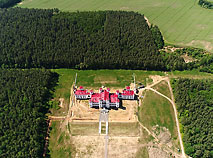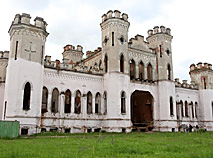Palace of the Puslovskys in Kossovo

A unique monument of neo-gothic architecture of the 19th century is situated in the Belarusian town of Kossovo. The Palace of the Puslovskys, or Kossovo Castle, has been nicknamed "knights’ dream" for its fairy-tale-like appearance and splendor.
History of Puslovskys Palace
 The Kossovo town (today’s Ivatsevichi District, Brest Oblast) was first mentioned in 1494 when Grand Duke of Lithuania Aleksandr Jagiellon presented these lands to Yan Khreptovich, a high-ranking state official of the Grand Duchy of Lithuania.
The Kossovo town (today’s Ivatsevichi District, Brest Oblast) was first mentioned in 1494 when Grand Duke of Lithuania Aleksandr Jagiellon presented these lands to Yan Khreptovich, a high-ranking state official of the Grand Duchy of Lithuania.
For several centuries Kossovo was owned by several distinguished dynasties: the Khreptovichs, Sanguszkos, Flemmings, Czartoryskis and Sapiehas. Wojciech Puslovsky bought the estate in 1821. He founded a carpet-making factory in Kossovo and built and restored about 60 churches in the neighborhood.
The Puslovskys took pride in their estate being neighbors with the manor in the Merechevschina village, which was the birthplace of national hero of Poland and the USA and honorary citizen of France Tadeusz Kosciuszko.
 After Wojciech Puslovsky the estate was inherited by his son Wandalin who was a major industrialist and art enthusiast. It was he who began the construction of the splendid palace in Kossovo in 1838.
After Wojciech Puslovsky the estate was inherited by his son Wandalin who was a major industrialist and art enthusiast. It was he who began the construction of the splendid palace in Kossovo in 1838.
The design of the palace was suggested by eminent architect Franciszek Jaszczold. In the second half of the 19th century the palace was renovated according to Wladyslaw Marconi’s design.
The palace in Kossovo is unique in its own way. It consists of the central two-storied building and two wings. Because of the rectangular merlons at the top of the towers the palace is often called a mini-castle.
Each tower symbolizes one month of the year, with four highest towers in the center standing for May, June, July and August when harvest is reaped.
 The palace boasts over 100 rooms with no walk-through rooms. Thanks to a system of corridors and a special location of the windows every year one of the palace’s rooms was flooded with sunlight for two and a half days. This was the time when the owners of the palace celebrated the Day of the Room adorning it and spending there most of the time.
The palace boasts over 100 rooms with no walk-through rooms. Thanks to a system of corridors and a special location of the windows every year one of the palace’s rooms was flooded with sunlight for two and a half days. This was the time when the owners of the palace celebrated the Day of the Room adorning it and spending there most of the time.
Kossovo Palace was famous for its magnificent audience chambers: the White Chamber was designed for noisy balls, the Black Chamber was used for card games while in the Pink one people usually played music.
Another room, the Ceremonial Chamber, was probably the most amazing one. It is said that the floor of this chamber was made of glass under which fish swam and algae grew. Today’s restoration experts have not confirmed this fact but they know for sure that the palace was equipped with an under-floor heating system.
 The palace was surrounded by a magnificent park with over 150 species of exotic plants. A special greenhouse was built for the most unique of them. The terraces of the park led down to three artificial lakes and the Kosciuszko estate.
The palace was surrounded by a magnificent park with over 150 species of exotic plants. A special greenhouse was built for the most unique of them. The terraces of the park led down to three artificial lakes and the Kosciuszko estate.
After Leonard Puslowski gambled away the estate, Kossovo changed hands several times. During the First World War the palace was plundered and its valuables were taken abroad. In 1921 a district administration office and a bee keeper school opened here.
During the Second World War the palace suffered the worst damage. For many days a fire blazed through its rooms in 1944 and destroyed the decoration of the chambers and left only the magnificent walls.
Lots of legends are connected with Kossovo Palace. Locals said that the owners kept a lion to guard the palace. At night the lion was released from the cage to roam about the corridors.
 The palace also had its special “musical” feature. If someone stands on the windowsill of the first floor in the eastern side of the building and clapped loudly the dome of the building will start emitting musical sounds.
The palace also had its special “musical” feature. If someone stands on the windowsill of the first floor in the eastern side of the building and clapped loudly the dome of the building will start emitting musical sounds.
One of the most beautiful legends says that there was an underground tunnel which linked the palace of Kossovo and the residence of the Sapieha family in Ruzhany. It was 25km long and "had the width of a carriage and a troika."
Puslovskys Palace today
 Despite the destruction the beauty of Kossovo Palace still impresses and attracts tourists. Since 2008 the site has been undergoing restoration which is set to finish in 2018.
Despite the destruction the beauty of Kossovo Palace still impresses and attracts tourists. Since 2008 the site has been undergoing restoration which is set to finish in 2018.
Kossovo Palace has turned into a social, cultural and tourism center. A museum, a mini-hotel and a restaurant will be opened here. There are also plans to restore the biggest terraced park in Belarus to its original condition.
Tourists from all over the world are welcome to visit the house-turned-museum of Tadeusz Kosciuszko which was restored and opened in 2004. It is noteworthy that it was the Puslovskys who restored the deserted Kosciuszko estate for the first time in 1857.
Kossovo Castle is part of a number of Belarus’ travel itineraries.
How to get to Kossovo and where to stay
Kossovo can be reached from Minsk by car. A great deal of the route will be covered by motorway M1/E30. In Ivatsevichi you have leave this motorway to take road P44 which leads to Kossovo. For the sake of convenience please see the map.
It is also possible to come to Kossovo by bus (a four hours’ trip from Minsk) or by train (the Ivatsevichi direction).
It is possible to stay in the hotel of the town Ivatsevichi.
Sights in Kossovo
In Kossovo you can visit the following places:

-
The house-turned-museum of Tadeusz Kosciuszko (the building was restored on the foundation of the 18th century)
-
The Roman Catholic Church of the Holy Trinity (1877). This is the place where Tadeusz Kosciuszko was baptized
-
The Orthodox Church of St. Anthony (1868)
-
The Church of Assumption (1871)
-
A Catholic chapel (1859)
Ruzhany Castle, a beautiful monument of Belarusian architecture, is located near Kossovo.
One kilometer from Ivatsevichi (in the direction of Kossovo) there is a geodetic point of the Struve Arc which is the biggest instrument for measuring the Earth (2,820km).







 print version
print version make home page
make home page add to bookmarks
add to bookmarks














